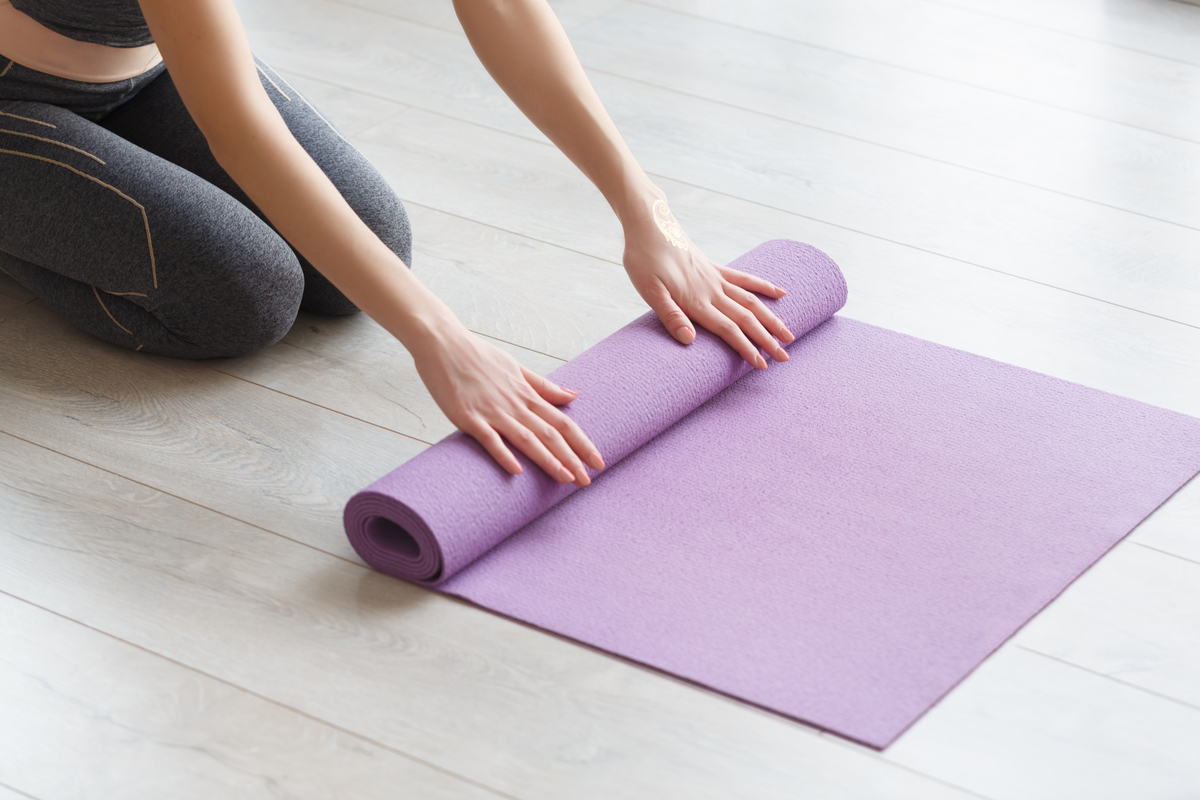Yoga can be a beautiful practice for your body and your mind: its benefits range from improving mental clarity to strengthening muscles to regulating emotional wellbeing.
But if you’re new to yoga, the whole experience has the potential to be overwhelming and confusing, which may complicate the stress-relieving benefits. Much of the practice is conducted in Sanskrit and Vedic phrases, which, if you’re unfamiliar, can be a lot. Plus, the structure and flow of every yoga class is often quite different, so even if you feel like you’ve got Hatha down, showing up to a Bikram class can be a bit mind-bending.
Yoga terms you need to know
To help mitigate a bit of your pre-yoga jitters, we’ve compiled an A to Z list of some helpful yoga terms and concepts you may like to know before you step into the studio and onto the mat.
What is ashtanga yoga?
This method of yoga involves synchronizing the breath with a progressive series of dynamic and physically demanding postures. Ashtanga yoga moves as a flow: it is great for building core strength and toning the body.
What is Bikram yoga?
Bikram is a series of twenty-six Hatha Yoga postures and two Pranayama breathing techniques designed to provide a challenging, invigorating and functional yoga experience. Bikram yoga is practiced in 90-minute sessions in a room at a temperature of 105 degrees Fahrenheit. (Here are some things to know about the benefits of hot yoga, too).
What is a chakra?
The Sanskrit word Chakra means “wheel” or “disk”. There are seven main chakras: Muladhara, Svadhisthana, Manipura, Anahata, Vishudda, Ajna and Sahaswara. These align along the spine, starting from the base through to the crown of the head. Chakras are conduits for prana (or life force) to move through the body.
[sc name=”saveupto70off” ]What is Dharma?
Dharma is a Hindu, Buddhist and yogic concept that refers to the idea of a law, or principle, governing the universe. For an individual to live out their dharma is for them to act in accordance with this law. In Buddhism, acting in this way is said to be the path to enlightenment. Dharma is closely related to the concepts of duty and service to others.
What is Eka Pada Bakasana?
Eka Pada Bakasana is also called one-legged crane pose. It’s an arm-balancing pose that occurs later in the balancing series of a Vinyasa practice. It requires a great deal of stability, balance, core strength and focus.
What is a yoga flow?
The art of moving continuously between poses. Flowing is a large part of the continuous movement of a Vinyasa practice.
What is Garudasana?
Garudasana, or Eagle Pose, is named for the divine bird creature Garuda. This is a twisting posture falls in the middle of the standing series and requires stability in the legs and core and flexibility in the hips and shoulders. To do this posture, one wraps one’s arms from the elbows upwards and legs from the knees downwards while sitting down into a semi-squat, arms pressing together and up in front of the face. Garudasana offers benefits for the immune system, helps to align the chakras and helps strengthen the ankles and hips for balance.
What is Hatha?
Hatha is a category that includes the practice of physical postures and breathing techniques to help bring peace to the mind and body. The ultimate goal of hatha yoga is to prepare the body for meditation. A Hatha practice is relatively gentle: it’s slower than a flow class and typically, postures are held for longer periods to access more depth and to calm the mind through stillness.
What is Iyengar Yoga?
Iyengar Yoga is a system of yoga and a lifestyle practice developed by yoga master B.K.S. Iyengar to provide tools to foster bodily health, vitality, mental clarity, emotional serenity and spiritual wellbeing. Classes focus on strength, stamina, flexibility, balance and concentration. They also incorporate a focused meditation.
What is Jivamukti Yoga?
Jivamukti was founded in 1984 by Sharon Ganon and David Life. Jivamukti is mainly vinyasa flow-style classes infused with Hindu spiritual teachings. A series of chants usually open the beginning of class followed up by a series of poses that align with the five tenets of Jivamukti yoga and philosophy. Central to the practice and teachings within Jivamukti is the principle of connection to the Earth as a living being.
[sc name=”yoga_cta” ][/sc]What is Kundalini Yoga?
Kundalini Yoga is a blend of Bhakti Yoga (the yogic practice of devotion and chanting), Raja Yoga (the practice of meditation and mental and physical control) and Shakti Yoga (a practice for power and energy). The term ‘Kundalini’ refers to a spiritual life force or energy that is conceptualized as a serpent coiled in the spine: the practice is meant to awaken and uncoil the serpent through the chakras up the spine, which distributes energy throughout the body. Many of the physical postures in Kundalini are meant to activate the core and spine; also, they exert pressure on meridians throughout the body to improve and control energy flow and direct it to specific points. Kundalini also focuses heavily on breathwork and meditation.
What does Lila mean?
The Sanskrit word for ‘play’ and ‘spontaneity’. You might hear this used in class as a way to access fun in a posture – and to not take the practice too seriously.
What is a mantra?
A mantra is used in silent repetition during movement to help keep the mind focused. It’s been said that in yoga, Asanas are postures of the body and mantras are postures of the mind. Mantras, when used in this fashion, are more like affirmations and help to keep you connected to a particular state of mind. This can also take the form of a sound or vibration that one uses to access a deep state of meditation.
A yoga class may begin with the instructor inviting students to set an intention for their practice, and may offer suggestions for mantras to use during class. Mantras like “I can” or “I surrender” can help maintain a connection to the state you wish to cultivate during your time on the mat.
What does Namaste mean?
Namaste is a Sanskrit greeting meaning “the divine in me honors the divine in you.” It is often spoken at the conclusion of a yoga practice.
What does Om mean?
‘Om’ is often chanted at the beginning or end of a yoga class. When chanted, Om vibrates at the frequency of 432 Hz – the same vibrational frequency found in all things throughout nature, so this is often regarded as the basic sound of the universe. Chanting it symbolically and physically tunes us into that sound and acknowledges our connection to everything in the world and the Universe. The rhythmic pronunciation and vibrations have a calming effect on the body and the nervous system similar to the effects of meditation.
What is Pranayama?
Pranayama are controlled breathing exercises and techniques used in yoga to calm and focus the mind and link the body and spirit in practice. It has been said to assist in achieving higher states of awareness. Prana is often discussed in terms of the direction of the flow of oxygen and energy.
What is Rechaka?
Rechaka is a Sanskrit word meaning “exhalation.” It refers to a form of yogic breathing in which the exhalation is lengthened, while the inhalation remains free.
What is Savasana?
Savasana, sometimes referred to as Corpse Pose may appear simple from the outside, it challenges the mind and body differently than a more strength- or flexibility-centric pose. One lays on the floor with arms and legs slightly spread (or supported on a bolster), grounded into the floor with no movement and natural breath. This pose emphasizes an awareness of the body’s natural breathing pattern and asks the practitioner to channel energy inward. Many yoga practices will end with Savasana.
What is Tadasana?
The foundation of all standing poses, Mountain Pose makes a great starting position, resting pose, or tool to improve posture. Stand with the bases of your big toes touching, heels slightly apart (so that your second toes are parallel). Arms hang at the sides, engaged but not rigid, and the pelvis sits evenly in the middle of the body, tilted slightly up to elongate the spine and create a lengthened vertical posture.
What is Utkatasana?
Utkatasana is often called “Chair Pose.” A deep squat, Utkatasana engages your legs, back and ankles. The literal translation of the word “Utkatasana” from Sanskrit is “powerful pose.” At the core level, Utkatasana teaches you how to find your seat of power within your pelvis at the center of your body.
What is Vinyasa?
Vinyasa is a style of yoga characterized by stringing postures together so that you move from one to another, seamlessly, using breath. Vinyasa classes offer a variety of postures and no two classes are ever identical (as opposed to Bikram or similar where the postures and the order in which they occur are always the same). Vinyasa is an athletic practice and often centers on a specific intention for the session.
What is Yama?
Yama is the first of the eight limbs of yoga outlined in the yoga sutras, or tenets of yoga. Yama is also sometimes called “the five restraints” because it describes what one should avoid to progress along the yogic path. The five yamas are ahimsa (non-violence, doing no harm), satya (truthfulness), asteya (non-covetouness), brahmacharya (sexual self-restraint) and aparigraha (non-possessiveness).
What is zen yoga?
Zen yoga is a term which is used to describe the physical and mental exercises practiced within the tradition of Zen Buddhism. This might include yoga postures, repetitive movements and flowing sequences, which seem more like Tai Chi. They are all intended to prepare the body for sitting in meditation, much like the origins of Hatha yoga. They also help to cultivate mindfulness and body awareness.





